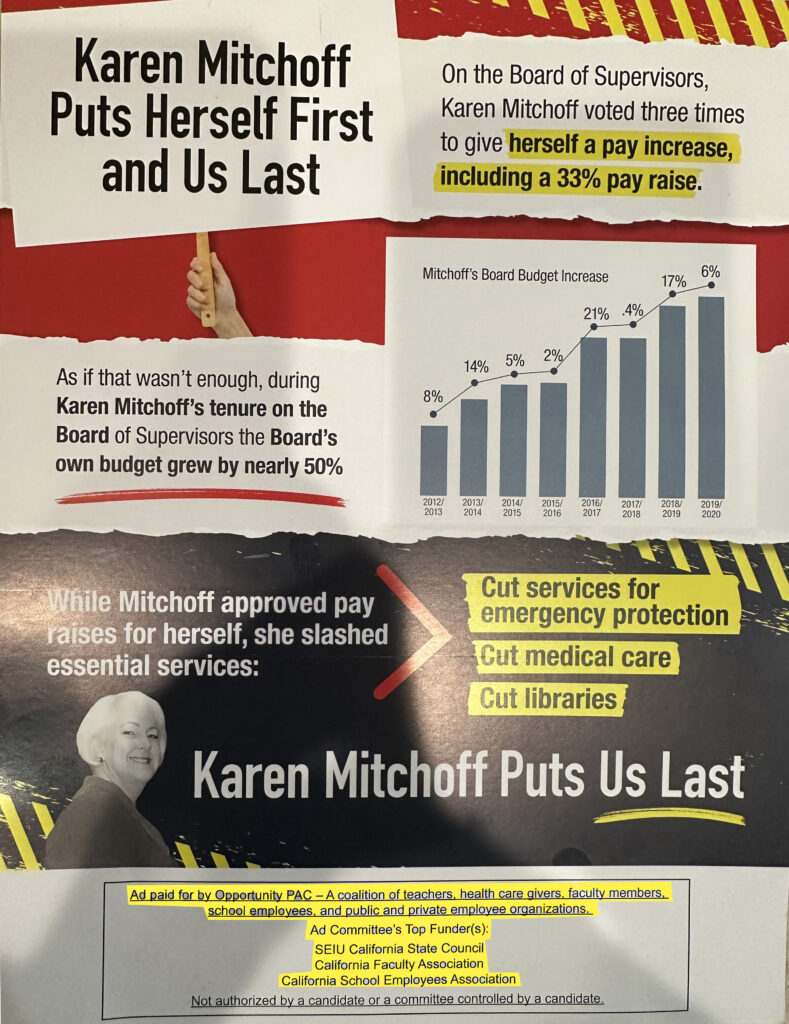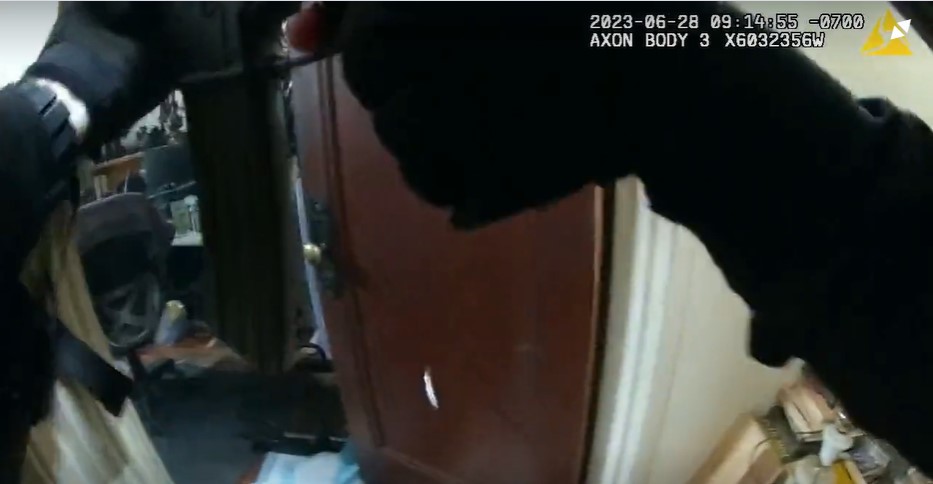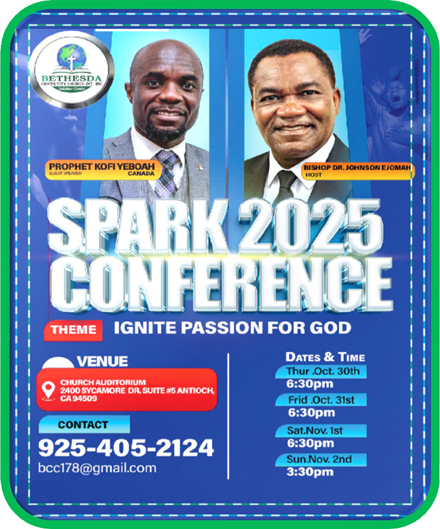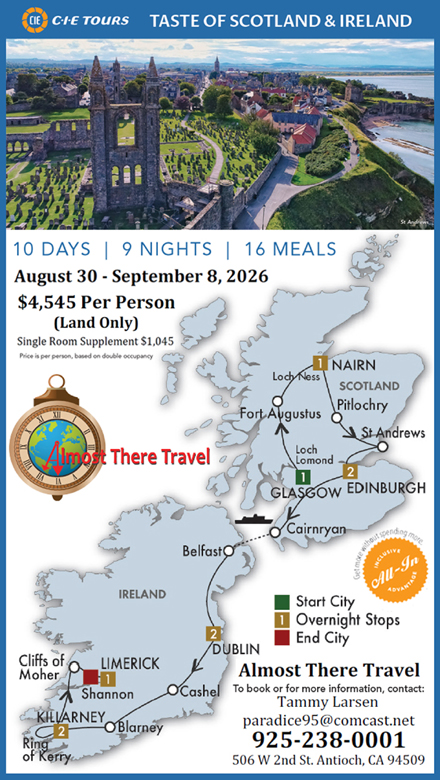Arrested Monday, as of Thursday 18-year-old released from custody on court order
By Brentwood Police Department
Early Monday morning, Feb. 26, 2024, around 2:00 AM, Brentwood Officers were dispatched to Bartlett Court and Malaga Way for a report of a car burglary that just occurred. The victim told Dispatch that they had heard glass breaking from outside of the home, and upon looking to see what it was, a suspect wearing all black clothing was seen running from their car.
When officers arrived the suspect was gone, however they determined a car burglary had just occurred and blood was found at the scene.
Shortly after, Dispatch was notified of an additional car burglary that occurred nearby at the 700 block of Brooks Street. A Brentwood Sergeant, who was patrolling the area, made contact with a male who matched the description of the suspect.
The male, identified as 18-year-old Antonio Ricardo Zamora of Brentwood, was found to have fresh cuts on his hands and a significant amount of property that officers determined were stolen from the recent car burglaries.
Upon further investigation, officers confirmed that Zamora was responsible for a total of four burglaries, and a suspect in four additional car burglaries; as well as vandalism of a car where it was believed he was attempting to break into.
Zamora was transported to the Martinez Detention Facility and booked for multiple counts of burglary.
The Brentwood Police Department commends the swift and diligent efforts of its officers in apprehending the suspect and preventing further criminal activity in our community. We remind residents to remain vigilant and report any suspicious behavior to law enforcement.
According to recentlybooked.com, Zamora is 5-feet, 9-inches tall and weighs 150 lbs. According to the Contra Costa County Sheriff’s Department, as of Thursday, Feb. 29, Zamora was released by court order.
Allen D. Payton contributed to this report.
Read More
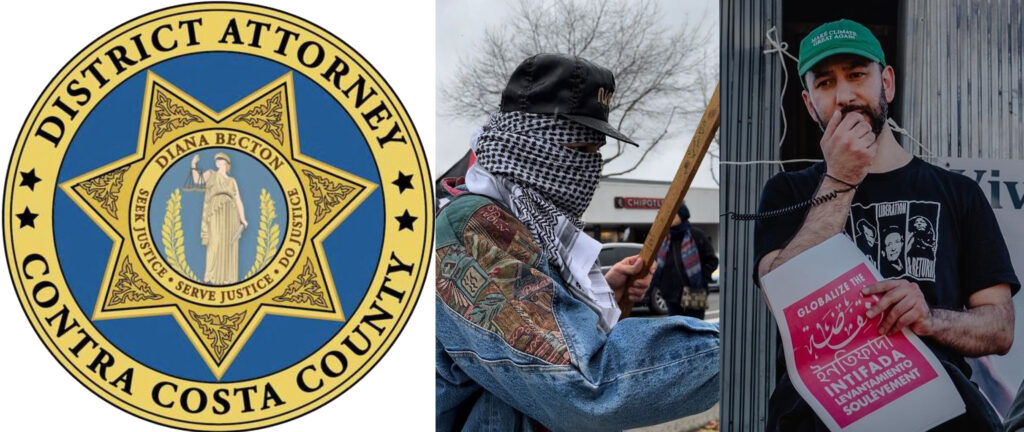
Christopher Khamis Victor Husary during the Jan. 6, 2024, protest in El Cerrito (Photo: El Cerrito PD) and at another protest in his profile photo posted on his Facebook page on Feb. 7, 2024, and his Instagram account on or before Feb. 1, 2024.
For hate crimes, robbery, arson during actions at Israel-Gaza protest, counter-protest
By Ted Asregadoo, PIO, Contra Costa District Attorney’s Office
The Contra Costa District Attorney’s Office has filed a three-count felony complaint with special hate crime allegations attached to each charge against 36-year-old Christopher Khamis Victor Husary of Hayward for criminal offenses that occurred during a protest in El Cerrito. (See related article)
On January 6th, 2024, a gathering of protesters and counter-protesters assembled in Albany for a demonstration on the war between Israel and Hamas in Gaza’s Palestinian territory. While participating in the protest in El Cerrito, Husary attacked a woman, taking an Israeli flag she was carrying, and set it on fire. Also, Husary pushed another woman and took another Israeli flag that was draped around her shoulders.
The El Cerrito Police Department initiated an investigation into the incident, and with the assistance of the public, police investigators were able to identify Husary as the individual responsible for the offenses. On February 28th, a warrant for his arrest was issued. Police also served Husary with a search warrant of his residence in Hayward – which produced additional evidence that linked him to the charged crimes.
He is currently in the Martinez Detention Facility and will be arraigned in Superior Court of California, County of Contra Costa on the following charges:
- Second Degree Robbery [PC 211]
- Grand Theft Person [PC 487(c)]
- Arson of Property of Another [PC 451(d)]
- Special Allegations – Hate Crimes [PC 422.75(a)]
District Attorney Diana Becton emphasized that “While the First Amendment is fundamental to our democracy, it doesn’t protect threats, injury, intimidation, or property damage. Moreover, when such actions stem from biases related to race, gender, religion, ancestry, or national origin, they become hate crimes.”
Case No. 02-24-00279 | The People of the State of California v. Husary, Christopher
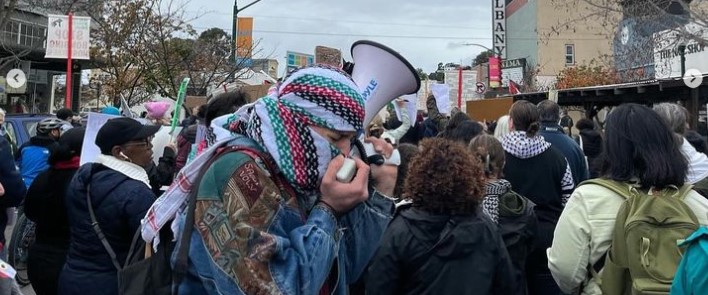
Christopher Khamis Victor Husary seen with a megaphone at a protest on Solano Avenue in Albany, CA in a photo posted on his Instagram account on or before Feb. 1, 2024.
In a video posted on his Instagram account on or before Feb. 1, 2024, Husary can be seen marching with other protesters on Solano Avenue in Albany, CA and heard yelling chants through a megaphone which were repeated by the others, “Free, free, free Palestine. Occupation is a crime. Genocide is a crime. Netanyahu, you can’t hide. Killing children is a crime. Killing women is a crime.”
Allen D. Payton contributed to this report.
Read More
Bags of marijuana packaged for sale and guns seized from two suspects on Feb. 19, 2024. Photo: Hercules PD
By Hercules Police Department
On Feb. 19, 2024 at approximately 4:24PM Hercules Police Officers were dispatched to Home Depot for a theft in progress. Officers contacted the two subjects as they exited Home Depot and approached a Chevy Cruze parked in a handicap spot, with the engine running, and an infant left alone in a car seat. Officers recognized the subjects, and one subject was known to be on Felony Probation for Robbery.
A probation search of the vehicle was conducted. Officers located large quantities of marijuana packaged for sales and promethazine with no prescription label. Officers arrested both subjects for suspected drug violations and child endangerment. A family member responded to the scene and took custody of the child.
Officers then conducted a probation search of one of the subject’s residence located in Hercules. Located inside of the residence was a larger quantity of marijuana as well as an unregistered Micro Draco assault weapon, and an unregistered pistol.
Both subjects were booked at Martinez Detention Facility on various firearm and marijuana charges.
Read More
Blake Harper Trujillo with dad, Timothy and mom, Josephine Trujillo born Feb. 29, 2024, at Kaiser Antioch Medical Center. Photo: Kaiser Permanente
By Antonia Ehlers, PR and Media Relations, Kaiser Permanente Northern California
Pittsburg mother-to-be Josephine Trujillo had a big surprise Wednesday night – she went into labor! What began as a trip to see a midwife at the Kaiser Permanente Delta Fair Medical Offices ended at the Kaiser Permanente Antioch Medical Center. A few hours later – at precisely 12:04 a.m. Thursday, Feb. 29, 2024, – Josephine gave birth to baby Blake Harper. The adorable baby with lots of hair and steel blue eyes is one of the Bay Area’s first 2024 Leap Year babies.
Proud dad Timothy Trujillo, a project manager at the Worley Group, said the little bundle of joy weighed in at 9 pounds, 6 ounces and measured 21 inches.
“It feels surreal but excellent,” he said.
Josephine, a middle school science teacher at Edna Brewer Middle School in Oakland, said everything happened so fast once she went into labor.
“Our due date was February 27, but it was still a surprise,” she said. “Our care at Kaiser Permanente was amazing – they made it easy. Everyone was on top of it. ‘We’ve been calling him our ‘little chonker’ and we’re just ecstatic.”
“Congratulations to the Trujillo family on the birth of baby Blake,” said Pam Galley, Kaiser Permanente senior vice president and area manager for the Diablo Service Area. “Our health care team at the Kaiser Permanente Antioch Medical Center welcomed a very special Leap Year baby today, and we wish his family all the best.”
Read More
Christopher Khamis Victor Husary during the protest in El Cerrito on Jan. 6, 2024. Photo: El Cerrito PD
Charged with robbery, grand theft and arson.
By El Cerrito Police Department
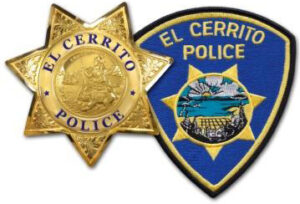 On Saturday, January 6, 2024, a group of protesters and counter-protesters arrived in the City of El Cerrito and took over the intersection of San Pablo Avenue and Carlson Boulevard. The El Cerrito Police Department became aware of an incident that occurred during the protest wherein a male protester pushed a woman down to the ground from behind causing minor injury and then he took her flag by force. The suspect then burned the woman’s flag in the street.
On Saturday, January 6, 2024, a group of protesters and counter-protesters arrived in the City of El Cerrito and took over the intersection of San Pablo Avenue and Carlson Boulevard. The El Cerrito Police Department became aware of an incident that occurred during the protest wherein a male protester pushed a woman down to the ground from behind causing minor injury and then he took her flag by force. The suspect then burned the woman’s flag in the street.
The department released photos of the suspect in the incident who was wearing a garment to cover his face. With help from the public, the department was able to identify the suspect and obtain a warrant for his arrest.
Wednesday morning, Feb. 28, 2024, at 7:00 AM, El Cerrito Police Officers arrested Christopher Khamis Victor Husary, a 36-year-old man from Hayward, on an arrest warrant stemming from his involvement in the incident.
A search warrant was served at Husary’s residence and investigators recovered additional evidence that implicated Husary in the crime. Husary was booked into the Martinez Detention Facility on one count of robbery, one count of grand theft from a person, and one count of arson.
According to the Contra Costa County Sheriff’s Department, the 6-foot tall, 165-lb. suspect (born Dec. 18, 1987) is being held on $115,000 bail.
The investigation will be forwarded to the Contra Costa County District Attorney’s Office with a request for prosecution.
According to localcrimenews.com, Husary was first arrested in 2006 by the San Joaquin County Sheriff’s Department for being intoxicated in public, then again in 2017 by the San Mateo County Sheriff’s Department for battery on a spouse, cohabitant or former spouse. He was arrested in December 2023 by San Francisco Police for vandalism of $5,000 or more.
Allen D. Payton contributed to this report.
Read More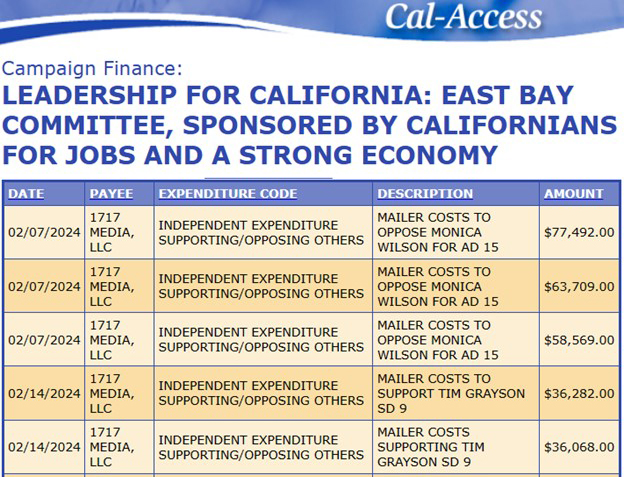
The Leadership for California: East Bay Committee financial disclosure reports show expenditures for three mailers against Monica Wilson in the Assembly District 15 race and two mailers supporting Tim Grayson in the State Senate District 9 race. Source: Cal-Access
Same PAC is supporting Grayson in Senate District 9 race
By Allen D. Payton
So far, a political action committee named “Leadership for California: East Bay Committee, Sponsored by Californians for Jobs and a Strong Economy” has spent $214,162 to oppose Antioch Mayor Pro Tem Monica Wilson in her campaign for the State Assembly District 15 seat.
To date, the PAC has paid for three mailers against Wilson between Feb. 7th to 15th, ranging in cost from $58,569 to $77,492, according to the PAC’s Form 460 financial disclosure report from Jan. 1 thru Feb. 17, 2024.
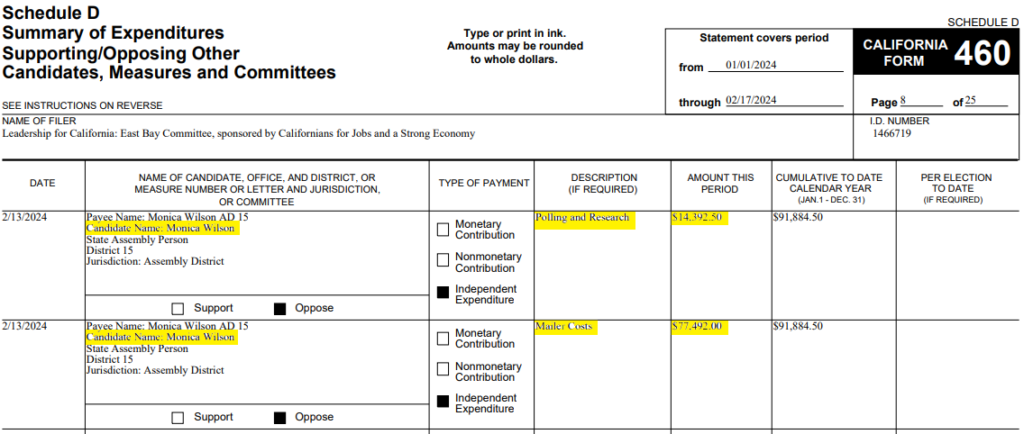
The Leadership for California East Bay Committe Form 460 report dated Feb. 17, 2024 shows expenditures for polling, research and a mailer against Wilson. Source: Cal-Access
According to Cal-Access, the California Secretary of State’s political campaign finance website, the PAC raised $333,392.50 as of Feb. 17, including:
$260,000 from Californians for Jobs and a Strong Economy ID# 1275549;
$49,000 from American Beverage Association California PAC;
$10,000 from Keeping Californians Working, a Coalition of Insurance Agents, Technology, Energy, and Health Care Providers; and
$14,392.50 as an in-kind non-monetary contribution by Brighter Future for All ID# 1463665 for polling and research.
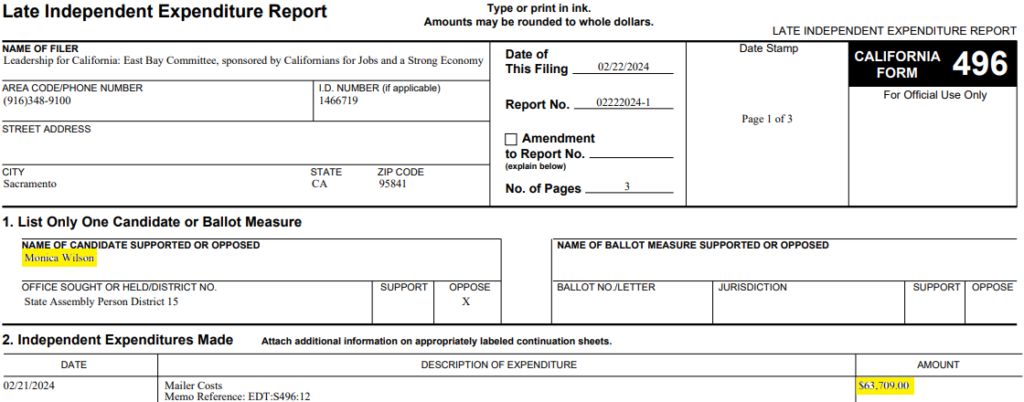
The Leadership for CA East Bay Committe Form 496 report dated Feb. 22, 2024, shows expenditures for another mailer against Wilson. Source: Cal-Access
Californians for Jobs and a Strong Economy Supported By Medical, Business Interests
According to Cal-Access, contributors to The Californians for Jobs and a Strong Economy PAC include the California Medical Association PAC, Target, Dart Container, Cooperative of American Physicians State PAC, Californians Allied for Patient Protection PAC, California Cable Telecommunications Association, Davita, Lyft, Peace Officers Research Association of California (PORAC) PAC, Fresenius Medical Care, In-N-Out Burgers, California Real Estate PAC, Chevron, PG&E, Walmart, Chime Financial, Inc., Anheuser-Busch Companies, McDonald’s Corporation and California Bankers Association State PAC.
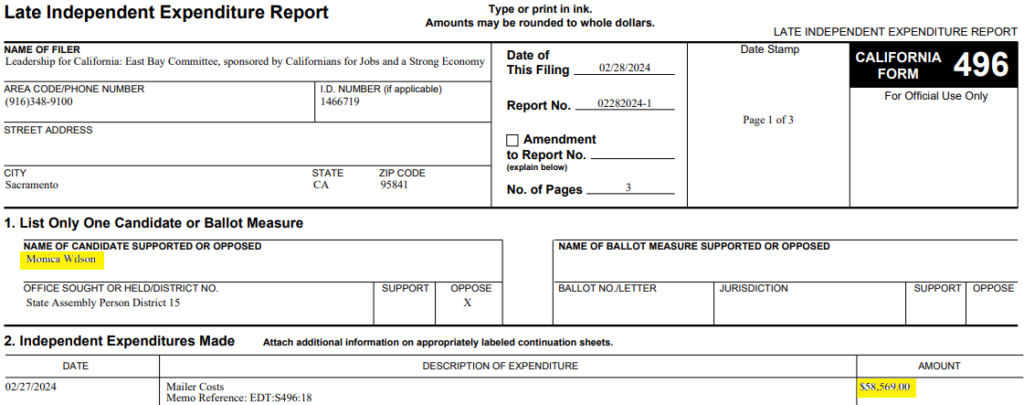
The Leadership for CA East Bay Committe Form 496 report dated Feb. 28, 2024, shows expenditures for a third mailer. Source: Cal-Access
Same East Bay PAC is Supporting Grayson for Senate
The same Leadership for California: East Bay Committee PAC also spent $72,350 on two mailers supporting Assemblyman Tim Grayson, for whose seat Wilson is seaking, in his campaign for State Senate District 9.
Wilson is facing three opponents in the race for Assembly District 15, including two fellow Democrats, County Board of Education Trustee Anamarie Avila Farias and former County Supervisor Karen Mitchoff, and one Republican, Realtor Sonia Ledo. The election is next Tuesday, March 5th and the top two vote-getters will face off in the November general election.
Read More
7-year-old boy discovered in suspects’ vehicle was child of driver; both suspects have history of arrests
By Lafayette Police Department
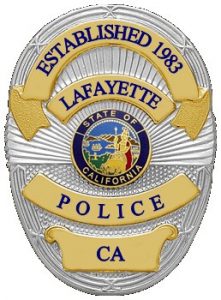 Wednesday afternoon, Feb. 28, 2024, at about 2 PM, Lafayette police officers responded to a report of a robbery at a fast-food restaurant on the 3500 block of Mt. Diablo Boulevard in Lafayette.
Wednesday afternoon, Feb. 28, 2024, at about 2 PM, Lafayette police officers responded to a report of a robbery at a fast-food restaurant on the 3500 block of Mt. Diablo Boulevard in Lafayette.
Officers identified the suspect vehicle and determined it was involved in armed robberies in Solano and Marin Counties earlier in the day.
At about 2:12 PM, a Lafayette officer located the suspect vehicle traveling westbound on Highway 24. The vehicle accelerated at a high rate of speed leading the officer on a pursuit that went west on Camino Pablo toward El Sobrante.
While on Camino Pablo (which turns into San Pablo Dam Road), the suspect vehicle apparently lost traction and collided with another car traveling in the opposing lane.
Two occupants in the suspect vehicle were taken into custody. They are identified as 24-year-old Jajuan Ojeda of Oakland and 39-year-old Aevra Traylor of Sacramento. Officers discovered a 7-year-old boy in the suspect vehicle who turned out to be the child of the driver. Ojeda and Traylor were booked into the Martinez Detention Facility and are facing charges that include robbery, felony evasion, and child endangerment. Both also had multiple warrants for their arrest.
The driver of the vehicle who was struck on San Pablo Dam Road was taken to the hospital as a precaution.
The investigation is ongoing.
According to localcrimenews.com, the 5-foot, 6-inch, 160-lb. Ojeda has a history of arrests dating back to 2017 inclulding once in December 2023, by the Sheriff’s Departments of Marin and Alameda counties and Oakland PD for crimes including carjacking, assault with a firearm, and multiple charges of evasion and resisting arrest.
According to localcrimenews.com, 5-foot, 5-inch, 165-lb. Traylor also has a history of arrests dating to 2017, including three times in December 2023, by the Sheriff’s Departments of Marin, Sacramento and Solano counties, Solano CHP and Castro Valley CHP for crimes including multiple vehicle thefts, driving with a suspended license, receiving stolen property, DUI, multiple gun charges, evasion of a police officer – driving on the wrong side of the road and wanton disregard for safety, and drug possession.
Allen D. Payton contributed to this report.
Read More
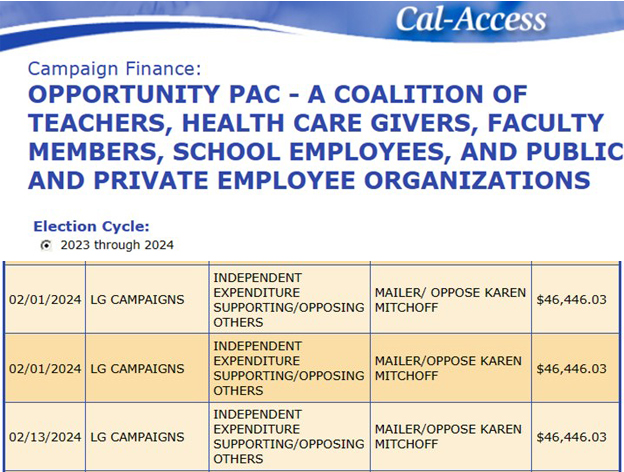
The Opportunity PAC’s financial disclosure reports show expenditures for three of the four “hit piece” mailers against Karen Mitchoff in the Assembly District 15 race. Source: Cal-Access
By Allen D. Payton
Some of the same unions backing Antioch Mayor Pro Tem Monica Wilson in the Assembly District 15 race on the March primary ballot have spent almost $253,000 attacking one of her three opponents, former Contra Costa County Supervisor Karen Mitchoff.
At least four mailers have been sent to Democrat voters in the district criticizing Mitchoff’s pay raise she voted for while on the board, and her votes against pay raises for county employees.
Two of the mailers obtained by the Herald show they were paid for by “Opportunity PAC – A coalition of teachers, health care givers, faculty members, school employees, and public and private employee organizations.” The political action committee’s Top Funders for the mailers are listed as SEIU (Service Employees International Union) California State Council, California Faculty Association (of the UC and CSU systems) and California School Employee Association.
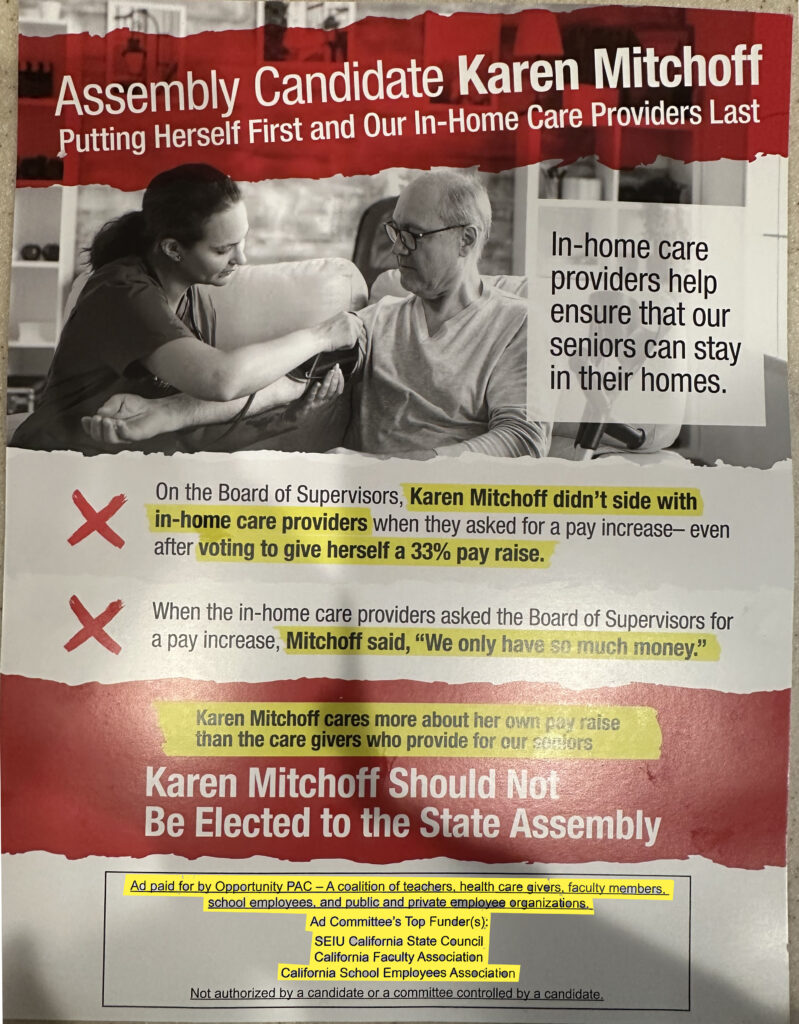
Another of four mailers opposing Mitchoff paid for by Opportunity PAC with a similar message about her vote for a pay raise for the Board of Supervisors.
When asked about the mailers Mitchoff said they’re all pretty much about the same issue. The same group with the same message. My decision was made over 10 years ago and I wanted to make sure the county supervisors were paid to make it a full-time position.” She also pointed out that she did vote for pay raises for county employees, “in 2022, giving them 5% a year for four years, for a total increase of 20%.”
The interesting part is that some of the state teachers’ unions including college and university faculty and staff are helping pay for the mailers, even though as a member of the Board of Supervisors, Mitchoff had no say about education funding.
According to Cal-Access, the California Secretary of State’s campaign finance reporting website, so far, the PAC has made three expenditures of $46,446.03 each for three mailers opposing Mitchoff, two on Feb. 1 and one on Feb. 13, 2024. The cost for a fourth mailer that appear under the PAC’s Accrued Expenses show an additional $46,446.03. That totals $185,784.12. In addition, the PAC spent $37,000.00 on polling and consulting and $30,126.43 on research in their effort against Mitchoff.
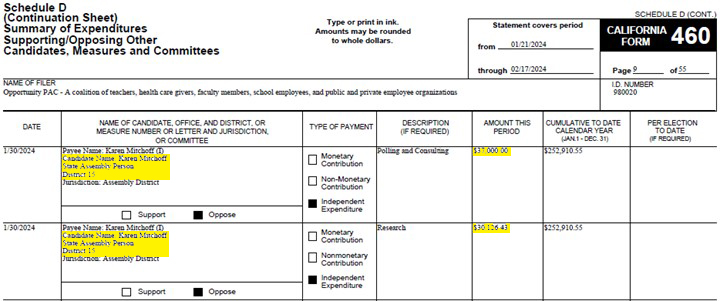
Other Opportunity PAC Expenditures opposing Mitchoff were for polling, consulting and research. Source: Cal-Access
Contributions to PAC Total Over $2.5 Million
The PAC is supporting and opposing a variety of candidates throughout the state. Their most recent Form 460 financial disclosure report dated Feb. 17, 2024, shows they have raised $1.715 million this year and their report ending Dec. 31, 2023, shows $803,500 was raised last year for a total of $2,518,500. They had cash on hand of over $1.1 million as of Feb. 17th.
Contributions include the following amounts and sources:
$750,000 from the California Teachers Association Independent Expenditure Committee;
$534,500 from SEIU California State Council for Working People;
$225,000 from PACE (Political Action for Classified Employees) of California School Employees Association;
$190,000 from Smart Justice California Action Fund;
$150,000 from United Food and Commercial Workers Western States Council Independent Expenditure PAC;
$150,000 from California Federation of Teachers COPE (Committee on Political Education);
$150,000 from Service Employees International Union Local 1000, Keeping California Healthy, Safe and Strong;
$100,000 from Service Employees International Union Local 721 CTW, CLC Workers’ Strength Committee;
$75,000 from SEIU United Healthcare Workers West PAC;
$59,500 from Faculty for Our University’s Future, a committee sponsored by California Faculty Association;
$59,500 from Standing Committee on Political Education of the California Labor Federation AFL-CIO;
$50,000 from the LGBT (Lesbian, Gay Bisexual & Transgender) Caucus Leadership Fund; and
$25,000 from SEIU California State Council (nonprofit 501 (c)(5))

Opportunity PAC Accrued Expenses as of their Feb. 17, 2024 report includes $46,446.03 for a fourth mailer opposing Mitchoff. Source: Cal-Access
Wilson’s Backers Funding Mitchoff Opposition Effort
Wilson’s campaign has been the beneficiary of support from many of those same unions. On her campaign website, Wilson shows endorsements by the California Faculty Association, SEIU California, National Union of Healthcare Workers (NUHW) and United Food & Commercial Workers Local 5, as well as unions that are members of the AFL-CIO.
Wilson and Mitchoff also face two others in the race, including County School Board Trustee Anamarie Avila Farias and Realtor Sonia Ledo in the March 5th primary election next Tuesday. The top two will face off in the November election.
Read More
By Jimmy Lee, Director of Public Affairs, Contra Costa County Office of the Sheriff
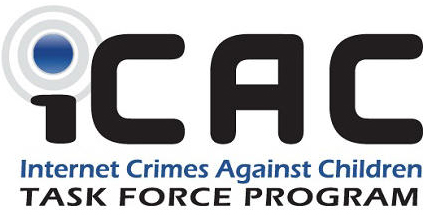 On Tuesday, February 27, 2024, at 10:33 AM, the Internet Crimes Against Children (ICAC) task force was conducting an enforcement operation.
On Tuesday, February 27, 2024, at 10:33 AM, the Internet Crimes Against Children (ICAC) task force was conducting an enforcement operation.
The ICAC task force in Contra Costa County includes investigators from the Walnut Creek, Brentwood, Pleasant Hill, San Ramon, Concord Police Departments, the Contra Costa County Sheriff’s Office, United States Secret Service, Homeland Security Investigations, and Inspectors from the Contra Costa County District Attorney’s Office.
Investigators went to a residence in Danville to arrest a suspect who solicited a detective posing as a 13-year-old boy for sex. The suspect, a 50-year-old Hispanic male out of Fairfield, CA, was arrested for arranging a meeting with a minor for lewd purposes (PC 288.4(b)), contacting a minor to commit a felony (PC 288.3(a)), at-tempted lewd acts on a child (PC 664/288(a)), attempted sending harmful material to seduce a minor (PC 664/288.2(a)(1), and resisting arrest (PC 148).
While being transported to the Martinez Detention Facility, the suspect
attempted suicide by hanging himself. Medical aid was rendered, and the suspect was transported to a local hospital. The investigation is ongoing.
Read MoreAfter he raised a pistol at officers
By Jimmy Lee, PIO, Contra Costa County Sheriff-Coroner’s Office
Sheriff-Coroner David Livingston announces that a coroner’s jury today reached a finding in the June 28, 2023, shooting death of 66-year-old Kevin James McDonald of Richmond by police. The finding of the jury is that the manner of death is suicide.
The coroner’s jury reached the verdict in the inquest after hearing the testimony of witnesses called by hearing officer Matthew Guichard.
As previously reported, On June 28, 2023, officers from the Richmond Police Department were involved in an officer-involved shooting in the 1200 block of Sanderling Island of Richmond.
Officers approached a closed bedroom door, which they opened while they announced themselves as being “Richmond Police”. As officers opened the door, they located McDonald seated on a bed, armed with an AR-15-style pistol. McDonald raised his weapon toward officers, at which time an officer-involved shooting occurred.
Officers provided medical aid to McDonald, who was pronounced deceased, by responding medical personnel. He had prior felony convictions that prohibited him from possessing firearms.
A subsequent search of the residence resulted in detectives locating a total of 53 firearms, including 23 pistols, 8 revolvers, 20 rifles, and two shotguns. A live hand grenade along with a large quantity of ammunition was seized. Materials to manufacture illegal firearms were also seized.
A coroner’s inquest, which Sheriff-Coroner David Livingston convenes in fatal incidents involving law enforcement personnel, is a public hearing during which a jury rules on the manner of a person’s death. Jury members can choose from the following four options when making their finding: Accident, Suicide, Natural Causes or At the hands of another person, other than by accident.
Allen D. Payton contributed to this report.
Read More







